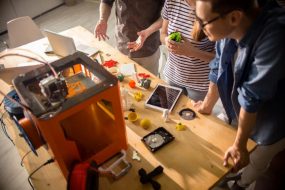3D Printing Safety at Work

3D printing, or additive manufacturing, is increasing in popularity. This technology is becoming less expensive and more accessible to both businesses and consumers. It is currently used in a wide variety of settings, such as labs, factories, hospitals, schools, libraries, and homes. Despite its popularity, 3D printing is still a relatively new technology and there are many gaps in the information available about health and safety risks. The National Institute for Occupational Safety and Health (NIOSH) is studying the potential hazards of 3D printing and ways to reduce health and safety risks for workers.
What is 3D printing?
3D printers create three-dimensional (or 3D) objects via computers. A computer file “tells” the 3D printer what object to create and how. 3D printers essentially stack layers of a material to get the desired product. Different types of 3D printers do this in different ways. For example, some use high temperatures, some use ultraviolet light, and others use lasers. 3D printers also use different print materials, such as plastics, rubbers, and metals.
Industries traditionally used 3D printing for prototyping. However, it is now also used for production. Industries using 3D printing include the automotive, aerospace, electronics, medical, and many others.
Potential Hazards of 3D Printing
3D printing hazards vary depending on the type of printer and materials used. For example, print materials that are powders are more likely to be inhaled or cause skin problems than others. 3D printers that use lasers have different hazards than printers that use high temperatures to melt materials. Some common hazards include:
- Breathing in harmful materials: 3D printing can release particulates and other harmful chemicals into the air.
- Skin contact with harmful materials: Users can get hazardous materials, such as metal powders, solvents and other chemicals, on their skin.
- Static, fire and explosion: Some materials used can be flammable or combustible. High temperatures from some printers can cause burns.
Ways to Protect Workers from 3D Printing Hazards
NIOSH has studied multiple ways to reduce exposure to 3D printing hazards. Some options include
- Limiting equipment access to trained or authorized personnel
- Using enclosures for 3D printers and ventilation to capture chemical emissions
- Using materials with lower emissions
- Reducing time spent near the printer while it is running
- Training workers on potential hazards and how to protect themselves
- Wearing appropriate personal protective equipment, such as safety glasses, gloves, or lab coats
The ways to reduce exposure depend on the type of printer and materials used. NIOSH has created two posters to help workers explore ways to reduce potential 3D printing hazards. One poster focuses on 3D printing with metal powders and the other focuses on filaments:
- 3D Printing with Metal Powders: Health and Safety Questions to Ask
- 3D Printing with Filaments: Health and Safety Questions to Ask
Help NIOSH Learn More about 3D Printing
Do you use 3D printing in your workplace? You can help NIOSH continue assessing 3D printing hazards and controls. Companies can contact the Nanotechnology and Advanced Materials Field Studies Team to assess possible work-related health hazards with 3D printing in their workplace.
